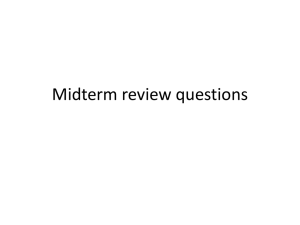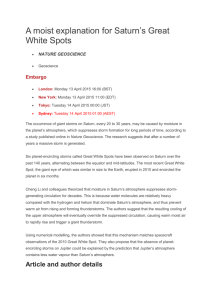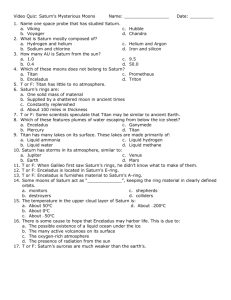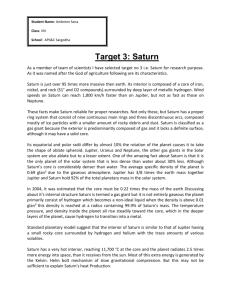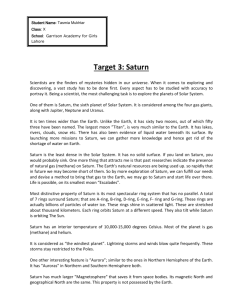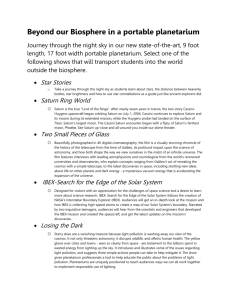Examples of requirement types using a Human Resources (HR
advertisement
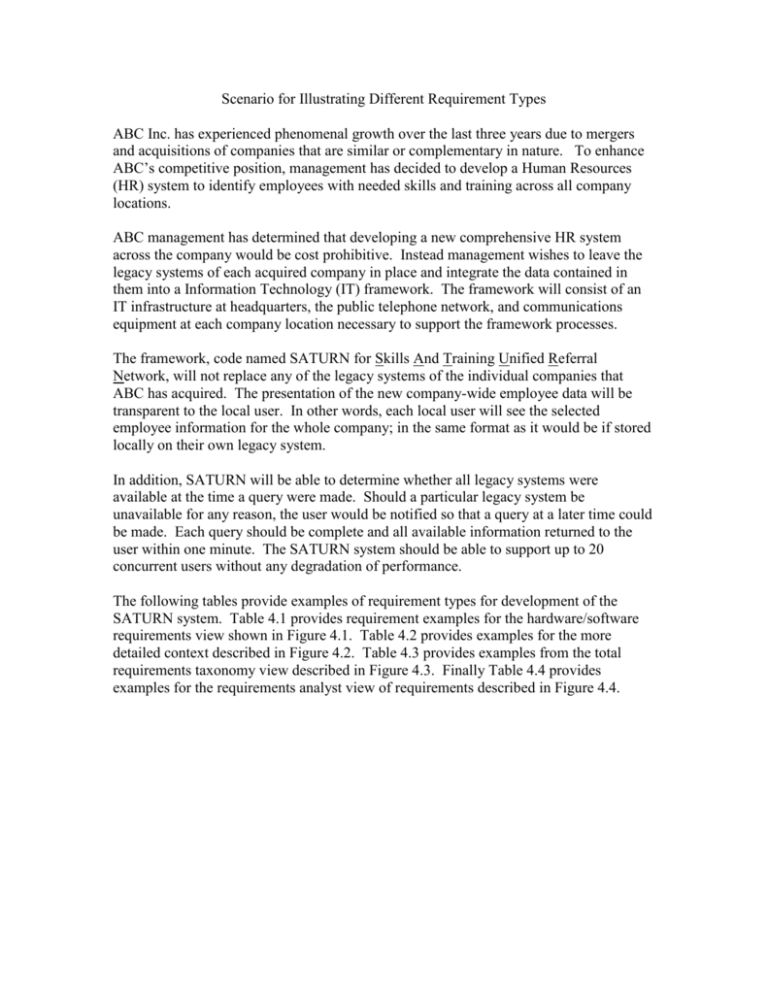
Scenario for Illustrating Different Requirement Types ABC Inc. has experienced phenomenal growth over the last three years due to mergers and acquisitions of companies that are similar or complementary in nature. To enhance ABC’s competitive position, management has decided to develop a Human Resources (HR) system to identify employees with needed skills and training across all company locations. ABC management has determined that developing a new comprehensive HR system across the company would be cost prohibitive. Instead management wishes to leave the legacy systems of each acquired company in place and integrate the data contained in them into a Information Technology (IT) framework. The framework will consist of an IT infrastructure at headquarters, the public telephone network, and communications equipment at each company location necessary to support the framework processes. The framework, code named SATURN for Skills And Training Unified Referral Network, will not replace any of the legacy systems of the individual companies that ABC has acquired. The presentation of the new company-wide employee data will be transparent to the local user. In other words, each local user will see the selected employee information for the whole company; in the same format as it would be if stored locally on their own legacy system. In addition, SATURN will be able to determine whether all legacy systems were available at the time a query were made. Should a particular legacy system be unavailable for any reason, the user would be notified so that a query at a later time could be made. Each query should be complete and all available information returned to the user within one minute. The SATURN system should be able to support up to 20 concurrent users without any degradation of performance. The following tables provide examples of requirement types for development of the SATURN system. Table 4.1 provides requirement examples for the hardware/software requirements view shown in Figure 4.1. Table 4.2 provides examples for the more detailed context described in Figure 4.2. Table 4.3 provides examples from the total requirements taxonomy view described in Figure 4.3. Finally Table 4.4 provides examples for the requirements analyst view of requirements described in Figure 4.4. Table 4.1 Hardware/Software Requirements View Examples. Hardware Requirements Performance The SATURN system shall complete all retrievals and display the requested information, within one minute of the user entering the query . Interface Requirement Specialty Engineering Requirement Environmental Requirement Software Requirements Functional Requirement Non-Functional Requirement Up to 20 concurrent users may use the SATURN system without any degradation of response time. The SATURN system shall operate through a commercially available browser such as Internet Explorer or Netscape. The SATURN system shall run on commercial off the shelf (COTS) hardware using the Microsoft Windows Operating System. The SATURN system shall operate on single phase commercially available power with a line voltage in the range of 110 volts plus or minus 20 volts AC. The SATURN system shall retrieve basic identifying information for all employees meeting the specified criteria. The SATURN system will generate error messages when a query fails to run to completion or a legacy system is not responding within the allotted time. Table 4.2 More Detailed Context Requirement Examples Production Process Requirement The SATURN system shall be available for use by all HR representatives at each company facility. Product Requirement The SATURN system shall retrieve basic identifying information for all employees who meet the pre-determined skills and training criteria. Test Process Requirement Test HR records for verifying the SATURN system will consist of a special set of personnel records at each company location specifically created with artificial data. Operational Process Requirement The SATURN system will have the same look and feel at each company location that users of the system at that location are familiar with, and therefore shall require no training. Table 4.3 Grady’s Total Taxonomy View Requirement Examples Process Functional Requirement The SATURN system shall be developed to provide company-wide access to employee skills and training information to all HR representatives. Process Interface Requirement Skills and training information from all company locations will be available to all other company locations. Process Specialty Requirement To ensure complete skills and training information are captured among the legacy systems, a data model shall be created. Process Environmental Requirement SATURN shall be developed using Joint Application Development teams (JAD) composed of users (HR representatives), developers, and system testers. Process Performance Requirement The SATURN system shall be ready for system acceptance testing within 180 days of project inception. Product Functional Requirement The HR user shall be able to retrieve employee skills and training data by predefined categories. Product Interface Requirement The SATURN system’s look and feel shall be identical to each local legacy system. Product Specialty Requirement The SATURN system shall use relational database technology. Product Environmental Requirement The SATURN system shall not require additional HVAC capacity be installed at any location. Product Performance Requirement The SATURN system shall operate with 97% reliability, 24 hours a day, 7 days a week. Table 4.4 Young’s Requirements Analyst View Requirement Examples Customer Needs and Expectations Examples (Requirements Analysis Input) Business Requirements Managers need access to timely and accurate data on personnel in order to meet operational needs. User Requirements The user needs the capability to search on Product Requirements Environmental Requirements System Requirements Specifications (Requirements Analysis Output) High-Level (or System Level) Requirements personnel across the entire company by pre-defined skill sets. Data formats shall be translated across legacy system boundaries into the format supported by the local user’s system. There shall be no operational impact to any user other than the impact on information retrieval caused by larger population of employees from which to select. The SATURN system shall maintain crossreferences for information types contained in the legacy systems. For example the field called “education_level” in one system is the same as “education” in another. The SATURN system shall convert data from each legacy system to the data expected by the local user. For example a masters degree in one system might be reflected in another system as “Grade 17.” Functional Requirements Non-functional Requirements Derived (or Design) Requirements and Design Constraints Performance Requirements Interface Requirements The local user shall be able to search all legacy systems in a predefined local, regional, or national geographical area for personnel meeting a specified skill-set. The SATURN system shall make use of the public switched network (PSN) and not require dedicated lines of communication. The SATURN system shall use Public Key Infrastructure (PKI) communications security. The SATURN system shall support up to 20 simultaneous users without any noticeable degradation of service. The SATURN system shall return all available skill-sets to the user within one minute of initiating a search. The SATURN system shall present a look and feel consistent with each local office’s legacy system.


